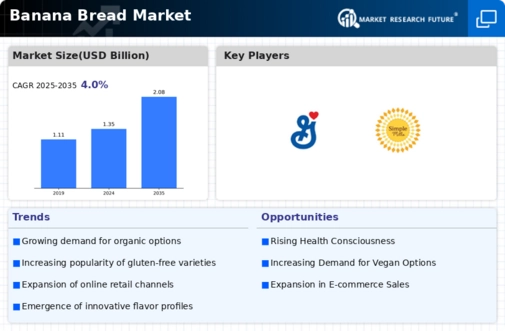Market Analysis
In-depth Analysis of Banana Bread Market Industry Landscape
The market dynamics of the banana bread market reflect a combination of consumer preferences, industry trends, and economic factors that shape demand and supply within the sector. One of the primary drivers of market dynamics is the enduring popularity of banana bread as a comfort food and versatile snack option. With its soft texture, sweet flavor, and nostalgic appeal, banana bread holds a special place in the hearts of consumers, driving consistent demand across various demographic groups. This steady demand serves as a foundation for market stability and growth, encouraging manufacturers to innovate and expand their product offerings to cater to evolving consumer preferences.
Moreover, health and wellness trends play a significant role in shaping market dynamics within the banana bread segment. As consumers increasingly prioritize healthier eating habits and seek out products with clean labels and natural ingredients, there is a growing demand for banana bread varieties that are lower in sugar, fat, and calories. Manufacturers are responding to this demand by offering healthier alternatives such as whole grain or gluten-free banana bread, incorporating natural sweeteners, and fortifying products with added nutrients and fiber. Additionally, the use of organic and sustainably sourced ingredients is gaining traction among environmentally conscious consumers, influencing purchasing decisions within the banana bread market.
Furthermore, the banana bread market is influenced by broader industry trends such as the rise of home baking and the proliferation of artisanal and gourmet products. With more consumers experimenting with baking at home and seeking high-quality, artisanal baked goods, there is a growing demand for premium banana bread mixes, baking kits, and ready-to-eat options. This trend is driving market players to focus on product differentiation, premiumization, and unique flavor profiles to stand out in a competitive market landscape. Additionally, the emergence of specialty bakeries, cafes, and online bakeries specializing in banana bread further contributes to market dynamism and diversity.
Another significant factor shaping market dynamics is the impact of seasonality and regional preferences. While banana bread enjoys year-round popularity, demand tends to peak during certain seasons or holidays, such as the fall and winter months or during festive occasions like Thanksgiving and Christmas. Additionally, regional variations in taste preferences and culinary traditions influence the types of banana bread products consumed in different markets. For example, tropical flavors or local ingredients may be favored in certain regions, leading to the development of region-specific banana bread varieties to cater to local tastes.
Moreover, economic factors such as disposable income levels, price sensitivity, and consumer spending patterns also impact market dynamics within the banana bread segment. During periods of economic uncertainty or recession, consumers may gravitate towards more affordable and value-oriented banana bread options, favoring budget-friendly mixes or homemade recipes over premium or gourmet offerings. Conversely, during times of economic prosperity, consumers may be more willing to indulge in higher-priced artisanal or specialty banana bread products, driving demand for premium options.
In addition to consumer-driven factors, regulatory policies and industry standards also play a role in shaping market dynamics within the banana bread segment. Government regulations related to food safety, labeling requirements, and ingredient sourcing influence product development, manufacturing processes, and marketing strategies within the industry. Market players must stay informed about regulatory changes and compliance requirements to ensure their products meet the necessary standards and regulations.






Leave a Comment